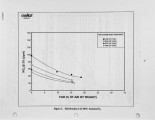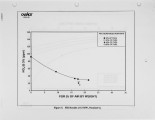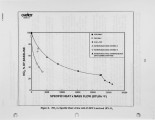| OCR Text |
Show 4 drum. Figure I shows a diagram of the FIR system. The steam injection system was operated manually and was equipped with manual shut-off valves~ a pressure regulator. an automatic shut-off valve in the event of high or low steam pressure or high fuel gas pressure, steam pressure and temperature gages, a purge line, and a manual control valve. Steam flow rate was monitored using an annubar with a high pressure differential manometer. Stearn was injected into the fuel gas header downstream of the fuel gas flow control valve and upstream of the burners. A valve and drain line were installed in the low point of the fuel gas supply line to each burner to allow the removal of any condensate that collected in the fuel gas lines. Summary of Results Laboratory E,'aluation The FIR process was previously evaluated in a gas-fIred package boiler with a capacity of 2 1v.tM:Btu/hr. FIR was evaluated using flue gas, air, and steam as the fuel diluent. The FIR process was evaluated over a range of boiler operating conditions including varying FGR to the combustion air and air staging using over fIre air ports. Steam and flue gas were found to be highly effective in reducing NOx emissions both with and without FGR and air staging. Air was much less effective. Figure 2 shows the results obtained using flue gas injection into the fuel with no air staging. The figure shows that the use of FIR alone is much more effective per unit flue gas recirculated than the use of FGR to the combustion air. Injection of 5 percent of the flue gas into the fuel with FIR was as effective as 15 percent FGR to the combustion air. Also, when FIR was combined with FGR, greater NOx emissions could be achieved compared to reductions that can be achieved with FGR only. Adding FIR to FGR provided an additional 50 percent reduction in NOx emissions. The use of steam for FIR was just about as effective as the use of flue gas. The use of air for FIR was much less effective than flue gas, and provided only about one-half the reductions that were obtained with the use of flue gas. Results at Highgrove Unit 3 FIR using steam injection into the fuel was evaluated over a wide range of FIR and FGR rates. Testing was perfonned at 25 MW (56 % load) and 15 Mw (34 % load) at nominal excess O2, Testing also was perfonned at 15 MW at high excess O2 to simulate combustion conditions on boilers operating at very low loads. The nominal excess O2 level represented a furnace O2 level of about 4.0% at 25 MW and 5.5% at 15 MW. The high excess O2 level at 15 MW corresponded to a furnace O2 level of about 10.5 %. NOx Reductions. Figures 3, 4, and 5 show NOx emissions as a function of FGR rate for the varying levels of FIR evaluated at 25 MW, 15 MW, and 15 MW with high excess O2• These figures show the NOx reductions typically achieved with FGR only, with NOx A054E562 .T |















